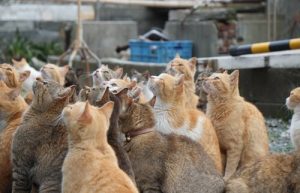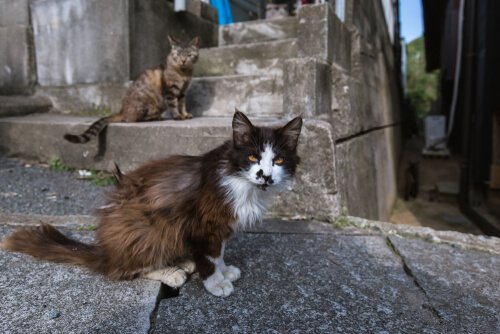Cat Islands In Japan

Off the coast of Japan, there are a few islands that have many more feline inhabitants than humans. These islands are known as the so-called cat islands. They’re very popular tourist destinations, but they might not be as happy as they seem. Below, you can read about Aoshima, one of the cat islands in Japan.
Where are the cat islands
Aoshima is one of the well-known cat islands. Only 15 people live there, but the feline population is more than 100. This island is located in the Ehime prefecture, in the southern region of the country.
Another one of the well-known cat islands is Tashirojima, which has around 10,000 visitors each year. It’s located in the Miyagi prefecture, in the third northern region of the country, and it’s located much closer to the coast than Aoshima.
In order to reach both of these islands, one must travel by boat from mainland Japan. In the right conditions, a trip to both of these islands would last about half an hour. Boat schedules vary depending on the season and the number of visitors. However, there is usually a limit of just a couple of trips per day.
How did they get so many cats?
The greatest attraction on these islands is the enormous number of cats that live on them. It’s estimated that there are six cats per inhabitant on the island of Aoshima. These animals depend on humans for food because there isn’t enough prey on the islands, which is why they are very docile and friendly.
They are familiar with the presence of strangers on the island due to a large number of tourists that visit the islands every year. These cats know how to pose for pictures and get visitors to feed them. Therefore, these cats aren’t like regular street cats that are found in other parts of the world.

The visitors that come to these islands find a postcard that’s difficult to find anywhere else in the world: hundreds of friendly cats that are easy to photograph and like to interact with people.
Despite being a cat sanctuary, cat islands are faced with a dilemma that’s difficult to solve. Due to such a large number of tourists that feed the cats, the islands are overpopulated with cats. Unfortunately, tourists don’t leave a sufficient financial impact on the islands in order to keep the cats healthy, sterilized and well-fed.
Cat island caregivers
According to several island visitors, many of these cats are affected by common and easily treatable diseases. The most common are respiratory and ocular infections, but many have wounds, skin problems and other conditions that derive from these problems.
Also, no one is responsible for sterilizing these cats, so they continue to uncontrollably reproduce, which is why the feline population on these islands continue growing.
A few years ago, groups of volunteers moved to the islands in order to treat the animals and launch the TNR project (Trap, Neuter and Return). Despite their efforts, the funding of this project wasn’t enough to tend all the cats that live on the islands.

When asked how to improve the felines’ quality of life, one of the islands’ visitors stated that he was doing a report:
“It’s a complex issue that doesn’t have a single solution. During our visit, we learned that we have to be aware of the impact our presence has on the animals in tourist destinations.”
The impact of tourism
In fact, the presence of foreigners on these islands have caused the cat population to grow so much that it’s now a tourist attraction. The more people that visit the island, the more food is available for the cats, thus the more they reproduce.
However, the presence of these tourists doesn’t ensure the cats’ health, the hygienic control in the area they live in and their veterinary care. It’s a vicious cycle in which, if tourism disappears, the cats will no longer have food. On the other hand, if tourism isn’t controlled, the cats will continue to multiply.
Aoshima and Tashirojima aren’t the only places where this happens. There are more than a dozen islands in Japan that are in the same situation. There are tourist destinations whose monkey or seagull populations are out of control because of the abundance of food.
Tourists that visit these destinations should be aware of the impact their presence on the world. It’s possible to be a responsible and ecological tourist who enjoys the wonders of the flora and fauna of our planet, without bringing a negative impact upon it.
This text is provided for informational purposes only and does not replace consultation with a professional. If in doubt, consult your specialist.